21st Century U.S. Military Documents: Air Force C-32B Special Airlift Aircraft - Operations Procedures, Aircrew Evaluation Criteria, Aircrew Training Flying Operations
Nonfiction, Science & Nature, Technology, Aeronautics & Astronautics, History, Military, Aviation| Author: | Progressive Management | ISBN: | 9781310509971 |
| Publisher: | Progressive Management | Publication: | October 27, 2013 |
| Imprint: | Smashwords Edition | Language: | English |
| Author: | Progressive Management |
| ISBN: | 9781310509971 |
| Publisher: | Progressive Management |
| Publication: | October 27, 2013 |
| Imprint: | Smashwords Edition |
| Language: | English |
Three Air Force documents provide unique information about USAF operations of this aircraft.
Contents: C-32B Operations Procedures * C-32B Aircrew Evaluation Criteria * C-32B Aircrew Training
Chapter 1 * GENERAL INFORMATION * 1.1. General * 1.2. Applicability * 1.3. Key Words Explained * 1.4. Deviations and Waivers * 1.5. Supplements * 1.6. Distribution * 1.7. Changes * Chapter 2 * COMMAND AND CONTROL * 2.1. General * 2.2. Operational Control (OPCON) * 2.3. Execution Authority * 2.4. Pilot In Command Responsibility and Authority * 2.5. Mission Clearance Decision * 2.6. Aircrew Responsibilities * 2.7. Operational C2 Reporting * 2.8. Mission Commander Responsibilities * Chapter 3 * CREW COMPLEMENT AND MANAGEMENT * 3.1. Aircrew Qualification * 3.2. Pilots * 3.3. Airborne Mission System Specialists (AMSS) and Loadmasters (LM) * 3.4. Crew Complement * 3.5. Additional Crew Members (ACM) * 3.6. Interfly * 3.7. Scheduling Restrictions (See AFI 11-202V3) * 3.8. Crew Rest * 3.9. Flight Duty Period (FDP) * 3.10. Crew Changes * 3.11. Alert Procedures * Chapter 4 * COMMAND OPERATING GUIDELINES * 4.1. Objectives * 4.2. Policy * 4.3. Operating Guidelines * Chapter 5 * AIRLAND OPERATIONAL PROCEDURES * 5.1. Checklists * 5.2. Duty Station * 5.3. Flight Deck Entry * 5.4. Takeoff and Landing Policy * 5.5. Landing Gear and Flap Operation In-Flight * 5.6. Use of Outside Observers * 5.7. Seat Belts * 5.8. Aircraft Lighting * 5.9. Portable Electronic Devices * 5.10. Smoking Restrictions * 5.11. Advisory Calls * 5.12. Communications Policy * 5.13. Transportation of Military Working Dogs * 5.14. Alcoholic Beverages * 5.15. Runway, Taxiway and Airfield Requirements * 5.16. Wind Restrictions * 5.17. Runway Condition Reading (RCR) * 5.18. Aircraft Taxi Obstruction Clearance Criteria and Foreign Object Damage (FOD) Avoidance * 5.19. Fuel Requirements * 5.20. Intersection Takeoffs * 5.21. Land and Hold Short (LAHSO) Operations * 5.22. Stop-and-Go Landings * 5.23. Reduced Power Operations * 5.24. Engine Out Takeoffs * 5.25. Engines Running On/Offload (ERO) * 5.26. Emergency Airlift * Chapter 6 * GENERAL OPERATING POLICIES * Section 6A—Premission * 6.1. Aircrew Uniform * 6.2. Personal Requirements * 6.3. Premission Actions * 6.4. Aircrew Publications Requirements * Section 6B—Predeparture * 6.5. Airfield Certification * 6.6. Aircrew Intelligence Briefing * 6.7. Flight Crew Information File (FCIF) * 6.8. Mission Kits * 6.9. Briefing Requirements * 6.10. Call Signs * 6.11. Instrument Flight Rules * 6.12. Flight Data Verification * 6.13. Departure Planning * 6.14. Obstacle Clearance Planning * 6.15. Takeoff Minimums and Departure Alternates * 6.16. Destination Requirements (for filing purposes) * 6.17. Destination and AAR Alternates * 6.18. Adverse Weather Planning * 6.19. Fuel Planning * 6.20. Mission Folder * 6.21. Navigation Kits * Section 6C—Preflight * 6.22. Aircraft Civilian Maintenance Forms * 6.23. En Route Aircraft Preflights * 6.24. Aircraft Servicing and Ground Operations * 6.25. Aircrew/Maintenance Engine Run-ups * 6.26. Towing * 6.27. Aircrew Flight Equipment Requirements * 6.28. Transponder Operations * 6.29. Dropped Object Prevention * 6.30. Narcotics * 6.31. Cockpit Congestion and Loose Objects * 6.32. Flight data recorder (FDR) and cockpit voice recorder (CVR) systems * 6.33. Passenger Policy * 6.34. One-time Flights * 6.35. Functional and Acceptance Check Flights (FCF and ACF) * Section 6D—Departure * 6.36. On Time Takeoffs * 6.37. Cabin Security Procedures for Takeoff and Landing * Section 6E—Enroute * 6.38. Flight Progress * 6.39. Navigational Capabilities * 6.40. Communications Instructions for Reporting Vital Intelligence Sightings (CIRVIS) and Other Reports
Three Air Force documents provide unique information about USAF operations of this aircraft.
Contents: C-32B Operations Procedures * C-32B Aircrew Evaluation Criteria * C-32B Aircrew Training
Chapter 1 * GENERAL INFORMATION * 1.1. General * 1.2. Applicability * 1.3. Key Words Explained * 1.4. Deviations and Waivers * 1.5. Supplements * 1.6. Distribution * 1.7. Changes * Chapter 2 * COMMAND AND CONTROL * 2.1. General * 2.2. Operational Control (OPCON) * 2.3. Execution Authority * 2.4. Pilot In Command Responsibility and Authority * 2.5. Mission Clearance Decision * 2.6. Aircrew Responsibilities * 2.7. Operational C2 Reporting * 2.8. Mission Commander Responsibilities * Chapter 3 * CREW COMPLEMENT AND MANAGEMENT * 3.1. Aircrew Qualification * 3.2. Pilots * 3.3. Airborne Mission System Specialists (AMSS) and Loadmasters (LM) * 3.4. Crew Complement * 3.5. Additional Crew Members (ACM) * 3.6. Interfly * 3.7. Scheduling Restrictions (See AFI 11-202V3) * 3.8. Crew Rest * 3.9. Flight Duty Period (FDP) * 3.10. Crew Changes * 3.11. Alert Procedures * Chapter 4 * COMMAND OPERATING GUIDELINES * 4.1. Objectives * 4.2. Policy * 4.3. Operating Guidelines * Chapter 5 * AIRLAND OPERATIONAL PROCEDURES * 5.1. Checklists * 5.2. Duty Station * 5.3. Flight Deck Entry * 5.4. Takeoff and Landing Policy * 5.5. Landing Gear and Flap Operation In-Flight * 5.6. Use of Outside Observers * 5.7. Seat Belts * 5.8. Aircraft Lighting * 5.9. Portable Electronic Devices * 5.10. Smoking Restrictions * 5.11. Advisory Calls * 5.12. Communications Policy * 5.13. Transportation of Military Working Dogs * 5.14. Alcoholic Beverages * 5.15. Runway, Taxiway and Airfield Requirements * 5.16. Wind Restrictions * 5.17. Runway Condition Reading (RCR) * 5.18. Aircraft Taxi Obstruction Clearance Criteria and Foreign Object Damage (FOD) Avoidance * 5.19. Fuel Requirements * 5.20. Intersection Takeoffs * 5.21. Land and Hold Short (LAHSO) Operations * 5.22. Stop-and-Go Landings * 5.23. Reduced Power Operations * 5.24. Engine Out Takeoffs * 5.25. Engines Running On/Offload (ERO) * 5.26. Emergency Airlift * Chapter 6 * GENERAL OPERATING POLICIES * Section 6A—Premission * 6.1. Aircrew Uniform * 6.2. Personal Requirements * 6.3. Premission Actions * 6.4. Aircrew Publications Requirements * Section 6B—Predeparture * 6.5. Airfield Certification * 6.6. Aircrew Intelligence Briefing * 6.7. Flight Crew Information File (FCIF) * 6.8. Mission Kits * 6.9. Briefing Requirements * 6.10. Call Signs * 6.11. Instrument Flight Rules * 6.12. Flight Data Verification * 6.13. Departure Planning * 6.14. Obstacle Clearance Planning * 6.15. Takeoff Minimums and Departure Alternates * 6.16. Destination Requirements (for filing purposes) * 6.17. Destination and AAR Alternates * 6.18. Adverse Weather Planning * 6.19. Fuel Planning * 6.20. Mission Folder * 6.21. Navigation Kits * Section 6C—Preflight * 6.22. Aircraft Civilian Maintenance Forms * 6.23. En Route Aircraft Preflights * 6.24. Aircraft Servicing and Ground Operations * 6.25. Aircrew/Maintenance Engine Run-ups * 6.26. Towing * 6.27. Aircrew Flight Equipment Requirements * 6.28. Transponder Operations * 6.29. Dropped Object Prevention * 6.30. Narcotics * 6.31. Cockpit Congestion and Loose Objects * 6.32. Flight data recorder (FDR) and cockpit voice recorder (CVR) systems * 6.33. Passenger Policy * 6.34. One-time Flights * 6.35. Functional and Acceptance Check Flights (FCF and ACF) * Section 6D—Departure * 6.36. On Time Takeoffs * 6.37. Cabin Security Procedures for Takeoff and Landing * Section 6E—Enroute * 6.38. Flight Progress * 6.39. Navigational Capabilities * 6.40. Communications Instructions for Reporting Vital Intelligence Sightings (CIRVIS) and Other Reports















